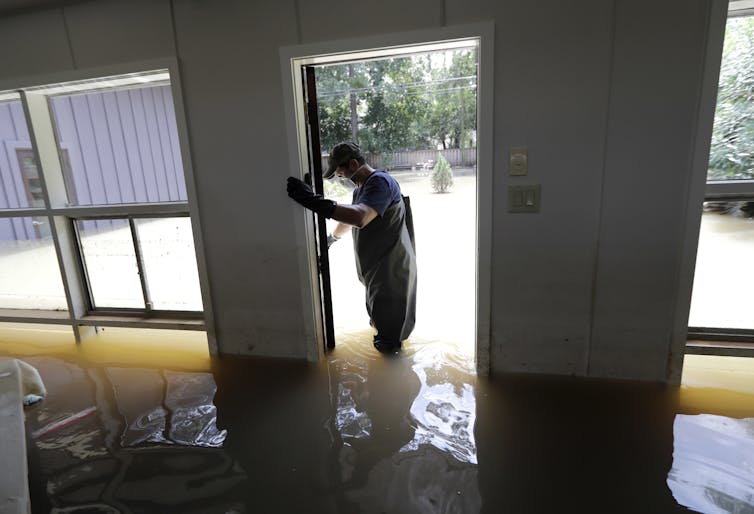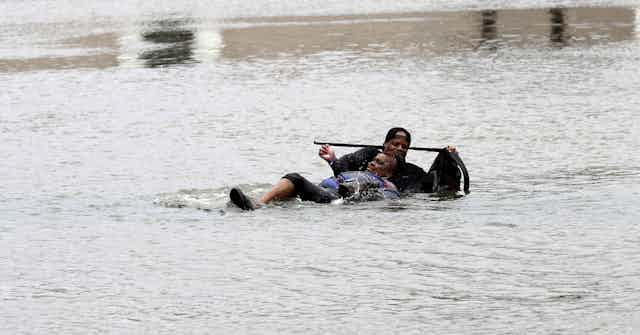In the aftermath of Hurricane Harvey, reporters warned of a “stew of toxic chemicals, sewage, debris and waste” in Houston’s floodwaters.
It isn’t just Harvey. Hurricanes Irma and Maria and other floods and storms heighten the risks for contamination, environmental hazards and disease. Public health experts frequently warn about the unique dangers to those evacuating from or returning to disaster-affected areas. Sadly, in the stress of the situation, these risks are often overlooked.
Before wading through floodwaters full of chemical spills, biotoxins, invasive species, waste, sewage and debris, it’s important to know what to watch out for and how to avoid getting hurt.
Bacterial illness
After epic hurricanes, bacterial illnesses are a common problem.
Hurricane floodwaters may be contaminated by sewage with E. coli bacteria, which can cause serious gastrointestinal illness. Bacterial pathogens such as Staphylococcus and Streptococcus can lead to skin infections. Shigella can cause gastrointestinal illness in the form of diarrhea, vomiting, fever, stomach pain and dehydration.
After Hurricane Katrina, surveys identified cases of Vibrio illness, a bacterial illness classically associated with exposure to saltwater or brackish water. This illness led to a handful of fatalities.
Storms and floods also increase the risk for leptospirosis. This bacterial disease, if left untreated, can lead to kidney damage, liver failure and even death.
Inhaling airborne moisture droplets can also put you at risk for Legionnaires’ disease, which is caused by Legionella, a freshwater bacteria that easily spreads to human-made water systems during floods. This can lead to pneumonia-type symptoms, as well as gastrointestinal illness.
One review found that storms heightened the risk of poisonings, wounds, gastrointestinal infections and skin or soft tissue infections, primarily from Staph and strep infections.
Many of these bacterial illnesses resolve on their own, but some require antibiotics. Tetanus prophylaxis vaccines can prevent bacterial infections through open cuts.

Toxic chemicals and gases
Chemical leaks and spills in floodwater can pose serious risks to human health.
When any flood or hurricane hits an urban industrial area, there’s a risk of toxic gases, such as as methane and sulfur dioxide, as well as industrial chemicals like benzene and butadiene, which can potentially cause cancer after large or chronic exposures. After Hurricane Harvey, more than 40 sites reportedly released hazardous pollutants.
Hurricane Harvey caused flooding or damage to at least 14 Superfund toxic waste sites in and around Houston. These sites are contaminated with dioxins, lead, arsenic and mercury, as well as other dangerous industrial compounds. These can cause serious health issues in the brain, blood and kidneys.
Many natural gas and other fuel lines were also broken during Hurricanes Harvey and Katrina. Abandoned buildings may host highly explosive gas vapors. Methane and other explosive gases may also accumulate from decaying materials.
Other threats
Floodwaters can make houses especially hospitable to mold, particularly in humid conditions like Texas, Puerto Rico and Florida. Multiplying mold spores carry serious public health risks, especially for people with existing mold allergies and asthma.
Standing water is also likely to cause an uptick in mosquito populations. Mosquitoes are vectors for a number of serious viruses, including Zika and yellow fever.
Standing water and humid conditions may also increase human encounters with venomous snakes, fire ants and stinging insects. Many of these animals may have been flooded out of their nests.
What’s more, rates of death may increase by up to 50 percent in the first year after a flood, secondary to outbreaks of diseases such as hepatitis E, gastrointestinal disease and leptospirosis.
What to do?
If you live in an area that’s at risk for hurricanes and storms, you can take steps now to protect yourself.
Make sure smoke and carbon monoxide detectors are properly functioning. You should also invest in basement sump pumps and flood insurance if you live near a river, coastline or floodplain. Flood insurance can give you the necessary support to quickly clean up, evacuate and repair damaged buildings.
Survivors of Harvey, Irma, Maria and other storms should make every effort to limit their contact with floodwater. Often, particularly in the aftermath, this can be unavoidable. If possible, wait until the water level goes down or try to obtain transportation by boat.
Open all windows when entering a building. If you smell gas or hear the sound of escaping gas, don’t smoke, operate electrical switches or create any other source of ignition. Leave the building immediately, leaving the door open. Don’t go back inside until you are told by authorities that it is safe to do so.
Remove standing water as quickly as possible. Remove wet materials and discard those that cannot be thoroughly cleaned and dried. Materials that have been wet for longer than 48 hours may need to be discarded, as they will likely remain a source of mold.
Dry out the building. This will take time and may require the extensive disinfection and removal of some materials. Heavily contaminated floodwaters can penetrate deep into soaked, porous materials such as drywall and wood, later releasing microorganisms and other contaminants into air or water. Microorganisms will continue to grow as long as materials remain wet and humidity is high.
When cleaning, limit exposure to airborne mold spores by wearing gloves, goggles and a respirator, if available, or a dust mask, so you can avoid breathing in contaminated vapor or mist. If there’s no standing water in the building and it’s safe to use electricity, use fans both during and after the use of cleaning products.
Exercise caution when disturbing building materials such as floor tiles, pipe insulation and paint. These may contain hazards such as asbestos and lead.
Many will use gas-powered generators to pump out floodwater. But beware – those generators can produce poisonous carbon monoxide gas in enclosed areas. In fact, cases of poisoning by carbon monoxide typically increase after disasters due to the improper use of fuel-burning devices.
You should also be on the alert for leaking containers and reactive household chemicals, like caustic drain cleaners and chlorine bleach. Stay away from leaking or spilled chemicals – even if a container is broken, it’s best to leave it undisturbed until it can be properly disposed of by authorities.

